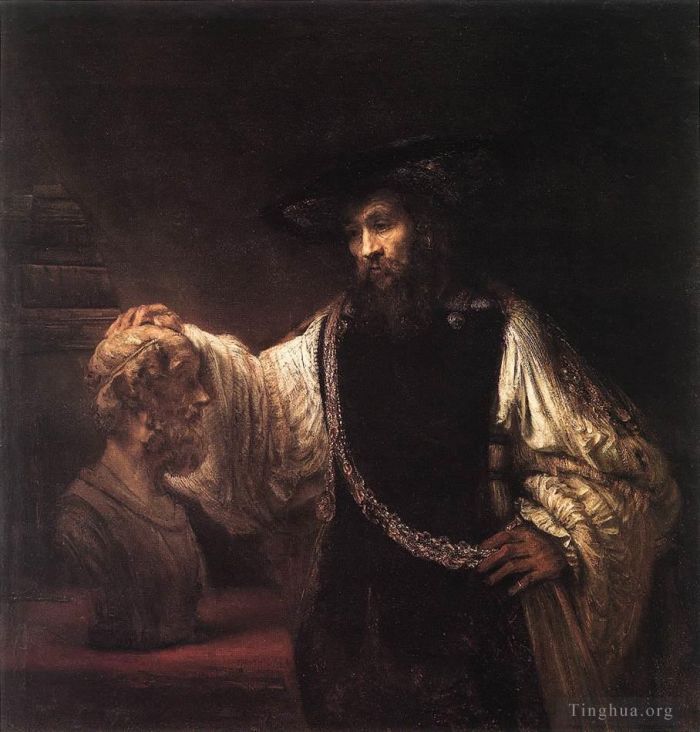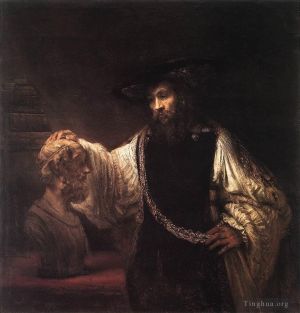Aristotle with a Bust of Homer
Rembrandt
- Price: Price on Request
- Art Type: Oil Painting
- Size:
- English Comments: 0
- International Comments: 0
- Creating Date:
- Introduction and Works of Rembrandt >>
Work Overview
- Aristotle Contemplating a Bust of Homer (Aristotle with a Bust of Homer)
Artist Rembrandt Edit this on Wikidata
Year 1653
Medium Oil on canvas
Movement Dutch Golden Age
Dimensions 143.5 cm (56.5 in) × 136.5 cm (53.7 in)
Location Metropolitan Museum of Art
Aristotle with a Bust of Homer, also known as Aristotle Contemplating a Bust of Homer, is an oil-on-canvas painting by Rembrandt.
It was painted in 1653, as a commission from Don Antonio Ruffo, from Messina in Sicily, who did not request a particular subject.
Aristotle, world-weary, looks at the bust of blind, humble Homer, on which he rests one of his hands. This has variously been interpreted as the man of sound, methodical science deferring to Art, or as the wealthy and famous philosopher, wearing the jeweled belt given to him by Alexander the Great, envying the life of the poor blind bard.[1] It has also been suggested that this is Rembrandt's commentary on the power of portraiture.[1]
The interpretation of methodical science deferring to art is discussed at length in Rembrandt's Aristotle and Other Rembrandt Studies.[1] The author notes that Aristotle's right hand (traditionally the favored hand), which rests on the bust of Homer, is both higher and painted in lighter shades than the left hand on the gold chain given to him by Alexander.
The exact subject being portrayed in this portrait has been challenged in the book by Simon Schama titled Rembrandt's Eyes, applying the scholarship of Paul Crenshaw.[2] Schama presents a substantial argument that it was the famous ancient Greek painter Apelles who is depicted in contemplation by Rembrandt and not Aristotle.[3]
It was purchased in 1961 for $2.3 million by the Metropolitan Museum of Art[4] in New York City, USA. At the time this was the highest amount ever paid for any picture at public or private sale.[5] During the renovation of the Rembrandt wing of the Metropolitan Museum, the painting was retitled in November 2013 as Aristotle with a Bust of Homer.
The painting forms the central theme of Joseph Heller's 1988 novel Picture This.
This imaginary portrait, one of Rembrandt's best-known works, was painted for Don Antonio Ruffo, a wealthy Sicilian nobleman and Rembrandt's only foreign patron, who had asked Rembrandt for a portrait of a philosopher. The artist sent the painting to Messina (Sicily) in 1654. He was paid 500 Dutch florine (gulden) for it.
Rather than choose a single figure, the enormously inventive artist found a way to present three of the great men of antiquity: Aristotle, Homer, and Alexander the Great. Aristotle, the great Greek philosopher of the fourth century B.C., is shown in his library dressed in the robes of a Renaissance humanist. He rests his hand on a bust of Homer and wears a splendid chain bearing a medallion of Alexander the Great, who had at one time been Aristotle's pupil. The figure of Homer was certainly based on one of several Hellenistic busts owned by Rembrandt; the figure of Aristotle is reminiscent of Rembrandt's portraits of the Jews of the Amsterdam ghetto, whom he had often used as models in his biblical paintings. The solemn stillness of Aristotle's study, the eloquence of his fingers resting on the bust of the blind poet, and above all the brooding mystery in his face unite to communicate an image of deep thought.
Aristotle (384–322 B.C.) rests his hand reflectively on a bust of Homer, the blind epic poet of the Iliad and the Odyssey. A medallion representing Alexander the Great, whom Aristotle tutored, hangs from the heavy gold chain. The philosopher contemplates material rewards as opposed to spiritual values, with the play of light and shadow on his features suggesting the motions of his mind. Painted for the great Sicilian collector Antonio Ruffo, the picture also refers to Aristotle's comparison of touch and sight as a means of acquiring knowledge.
- Copyright Statement:
All the reproduction of any forms about this work unauthorized by Singing Palette including images, texts and so on will be deemed to be violating the Copyright Laws.
To cite this webpage, please link back here.
- >> English Comments
- >> Chinese Comments
- >> French Comments
- >> German Comments
- >>Report
- Bathsheba at Her Bath
- The Return of the Prodigal Son
- Balaam and the Ass
- Stormy Landscape
- Christ driving the moneychangers from the temple 1626
- Young Man At His Desk
- Haesje
- St Paul at his WritingDesk
- The Abduction Of Ganymede
- Self Portrait at an Early Age 1628
- Woman in bed
- History Painting
- David and Uriah
- The Blinding of Samson
- Susanna
- Portrait Of Joris De Caullery
- Portrait of Nicolaes Ruts
- Flora
- Christ In The Storm On The Sea Of Galilee
- The beheading of john the baptist
- The Toilet of Bathsheba
- Susanna and the Elders
- Saskia in Pompous Dress
- Anna and the Blind Tobit
- Samson And Delilah
- Saskia Laughing
- Cupid Blowing Soap Bubbles
- Dead peacocks
- Self Portrait 1659
- The Holy Family with Angels
- The Artists Son Titus
- The denial of peter 1660
- The Baptism Of The Eunuch
- Repentant Judas Returning The Pieces Of Silver
- Portrait of the Artist at His Easel 1660
- Self Portrait as a Young Man 1634
- Young Woman Trying Earrings
- The Stoning Of St Stephen 1625
- Portrait Of An Eighty Three Year Old Woman
- Christ and the Woman Taken in Adultery
- Self-portrait as the Apostle Paul
- Musical Allegory
- The Artist In His Studio
- Maria Trip
- Man In Oriental Dress
- Titus at his desk
- Self portrait 1628
- The Polish Rider
- Agatha Bas
- Adoration of the Shepherds
- Young Man
- The Mennonite Minister Cornelis Claesz Anslo in Conversation with his Wife Aaltje
- Frederick Rihel on Horseback
- David Playing The Harp To Saul
- Portrait of Maria Trip 1639
- Portrait Of Amalia Van Solms
- Portrait Of A Young Woman With A Fan
- The holy family night
- The Elevation Of The Cross
- Jan Rijcksen And His Wife
- Holy Family
- Abraham of Isaac (The Angel Stopping Abraham from Sacrificing Isaac)
- The Mill
- The Risen Christ Appearing to Mary Magdalen
- The Ascension Of Christ
- Portrait of Saskia van Uylenburgh
- Self Portrait 1658
- Elder
- Portrait of Haesje van Cleyburgh
- Saul and David
- Landscape with the Rest on the Flight into Egypt
- The Conspiration of the Bataves
- Self portrait Det
- Portrait Of A Man
- The Holy Family
- Self
- Christ and St Mary Magdalene at the Tomb
- Joseph Accused by Potiphars Wife
- Artemisia
- Supper at Emmaus
- Christ Driving The Money Changers From The Temple
- The Prodigal Son in the Brothel (Rembrandt and Saskia in the Scene of the Prodigal Son in the Tavern)
- Sampling Officials of the DrapersGuild
- Danaë
- Winter Landscape
- Johannes
- JohDet
- Dr Ephraim Bueno Jewish Physician and Writer
- Saskia
- Self Portrait 1660
- Titus van Rijn in a Monks Habit
- Apostle Paul
- Samson at the Wedding
- St John The Baptist Preaching
- Portrait of Maria Trip
- The Night Watch
- Descent from the Cross
- Self Portrait 1669
- Portrait of Saskia with a Flower
- The Prophetess Anna known ass Mother
- The Man with the Golden Helmet
- David and Jonathan
- The Archangel Leaving the Family of Tobias
- Rape of Proserpina
- Portrait Of Maerten Soolmans
- Jeremiah Lamenting the Destruction of Jerusalem
- The Jewish Bride
- Christ on the cross 1631
- The Stone Bridge 1638
- Diana Bathing With The Stories Of Actaeon And Callisto
- Philosopher Reading
- Portrait Of A Woman
- The Anatomy Lesson of Dr Nicolaes Tulp
- Tobit and Anna with the Kid
- Peter Denouncing Christ
- Girl at a Window (Girl Leaning on a Stone Window Sill)
- The Raising of Lazarus
- Saskia Wearing A Veil
- Saskia As Flora
- The Visitation
- The Parable of the Rich Fool (The Rich Man from the Parable)
- Family Group
- Joseph Dream in the Stable in Bethlehem
- The Holy Family with a Curtain
- Deposition from the Cross
- Portrait Of An Old Man
- Self Portrait In A Gorget
- Portrait Of Alijdt Adriaensdr
- Slaughtered Ox (Flayed Ox or Side of Beef or Carcass of Beef)
- Portrait of Nicolaas van Bambeeck
- Portrait Of The Artist In A Flat Cap
- Philosopher in Meditation
- Self Portrait In A Plumed Hat
- The Incredulity of St Thomas
- Self Portrait 1629
- Self Portrait as the Apostle St Paul
- Two Old Men Disputing
- Aristotle with a Bust of Homer
- Belshazzars Feast
- Hendrickje Bathing in a River
- Portrait Of Maria Bockenolle
- Jacob
- Landscape with a Castle
- Portrait of Johannes Wtenbogaert
- Evangelist Matthew
- Self portrait 1632
- Portrait of a bearded man
- Self portrait 1640
- Jacob Blessing the Children of Joseph
- Portrait of a man in military costume
- The Dream of St Joseph
- Hendrickje Slapend RJM
- Portrait of Willem Bartholsz Ruyter
- In Velvet Cap and Plume SIL
- The Sense Of Sight
- Abraham Entertaining the Angels SIL
- Portrait of Willem Bartholsz Ruyter RJM
- Self Portrait 16289
- Sakia Asleep In Bed
- Study from the Nude Man Seated before a Curtain SIL
- The Blindness of Tobit SIL
- Drawing at a window
- Portrait Of Cornelis Claesz 1640
- Saskia In A Straw Hat
- Self Portrait Staring
- The Artists Father
- Ephraim Bonus Jewish Physician SIL









 Singing Palette
Singing Palette